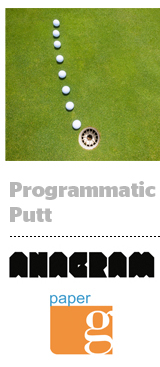 The programmatic pipes have been laid, but programmatic creative is still ramping up.
The programmatic pipes have been laid, but programmatic creative is still ramping up.
“There’s a disconnect between media and creative that prevents the industry from taking advantage of what’s possible,” said Adam Cahill, who left his post as EVP and chief digital officer at Hill Holliday in April to found Anagram, a consultancy/agency hybrid focused on melding creative, media and programmatic into a single strategy.
What’s possible, in Cahill’s view, is a smoother digital creative production process that doesn’t sacrifice the message for the media or vice versa.
“The message has been neglected in programmatic media and it’s probably the one thing that has the most impact on outcome,” Cahill said.
Regarding outcome, golf simulator brand OptiShot, the first client to join Anagram’s client roster, had a straightforward brief when it approached the agency: increase ecommerce sales during the slower summer season.
Rather than focusing on a single message, Anagram worked with Detroit Branding Co., OptiShot’s lead creative agency, to devise four overarching thematic umbrellas under which all the campaign messaging would reside: accessibility, time/convenience, weather/environment and quality/value.
An example of messaging under the “time and convenience” umbrella would be something like, “A golf course in your man cave,” while “quality and value” might say, “Just like a $30K golf simulator … for about 1/60th the cost.”
Each theme had at least four different messaging iterations, all of which needed to come in a plethora of ad sizes. Anagram’s strategy called for the development of several hundred discrete HTML5 display assets for OptiShot.
“Instead of trying to reduce it all down to one or two messages, our job was to find the aspects of the product that most appealed to the different pockets of audience and then to go all-in,” Cahill said.
To do that, Anagram enlisted PaperG, a creative management platform that enables agencies or advertisers to automate the creation of online ad campaigns by through rapid-fire development and versioning. As more versions are created, PaperG’s algorithm optimizes the creative based on campaign performance.
MediaMath handled the media for Anagram, which targeted 37 golf-related audience segments. Targeted Facebook ads, as well as a few private marketplace deals, where Anagram targeted consumers who had bought golf equipment in the past, rounded out the effort.
The campaign netted OptiShot a 565% increase in direct-to-consumer sales year over year, as well as an 85% lift in conversion rate, resulting in a 1.5x return on ad spend.
“I firmly believe that pretty much all media is going to be transacted programmatically,” Cahill said. “And there’s a real opportunity to combine a data-driven approach with some real thoughtfulness on the creative and messaging side.”
That’s not the case today, however, partially due to legacy agency processes that have outlived their usefulness. Old habits die hard, Cahill said.
Having sat in on many agency-side meetings in which third-party companies came to pitch their tech – prior to Hill Holliday, Cahill spent time at Carat – he noticed a tendency to “get out the checklist,” focusing on what a new solution can’t do rather than what it can.
“Someone might say, ‘Well, you can’t handle item No. 7, or whatever it is, on our process checklist,’ and that’s a problem – but the bigger issue is, maybe item No. 7 is totally useless and you don’t even need to be doing it anymore,” Cahill said. “You can poke holes in anything if you try.”
But in some cases, it’s simply a matter of bad – or no – communication between the media team and the creative team, which is something that Rob Lennon, senior product manager at PaperG, noticed while interacting with one of the company’s agency partners. The two no longer work together.
“Everyone agrees that more relevant creative impacts performance, but there’s no advantage to creatives actually doing the work that the media folks want them to do because that’s not how they’re compensated,” Lennon said. “In working with one agency, for example, we found out that the head of media and the head of creative didn’t even talk to each other very often. At one point, when we all sat down together at the same table, it was almost like they didn’t know each other. It blew my mind.”
Rather than peanut butter and jelly, two things that go well together, media and message are more like a car and its steering wheel – the former doesn’t really work all that well without the latter.
But creatives won’t feel that way if they’re not given more insight into and influence over campaign results, said Cahill.
“It’s not likely that a creative is going to win at Cannes by working on a programmatic campaign,” he said. “At least not in the next couple of years.”















